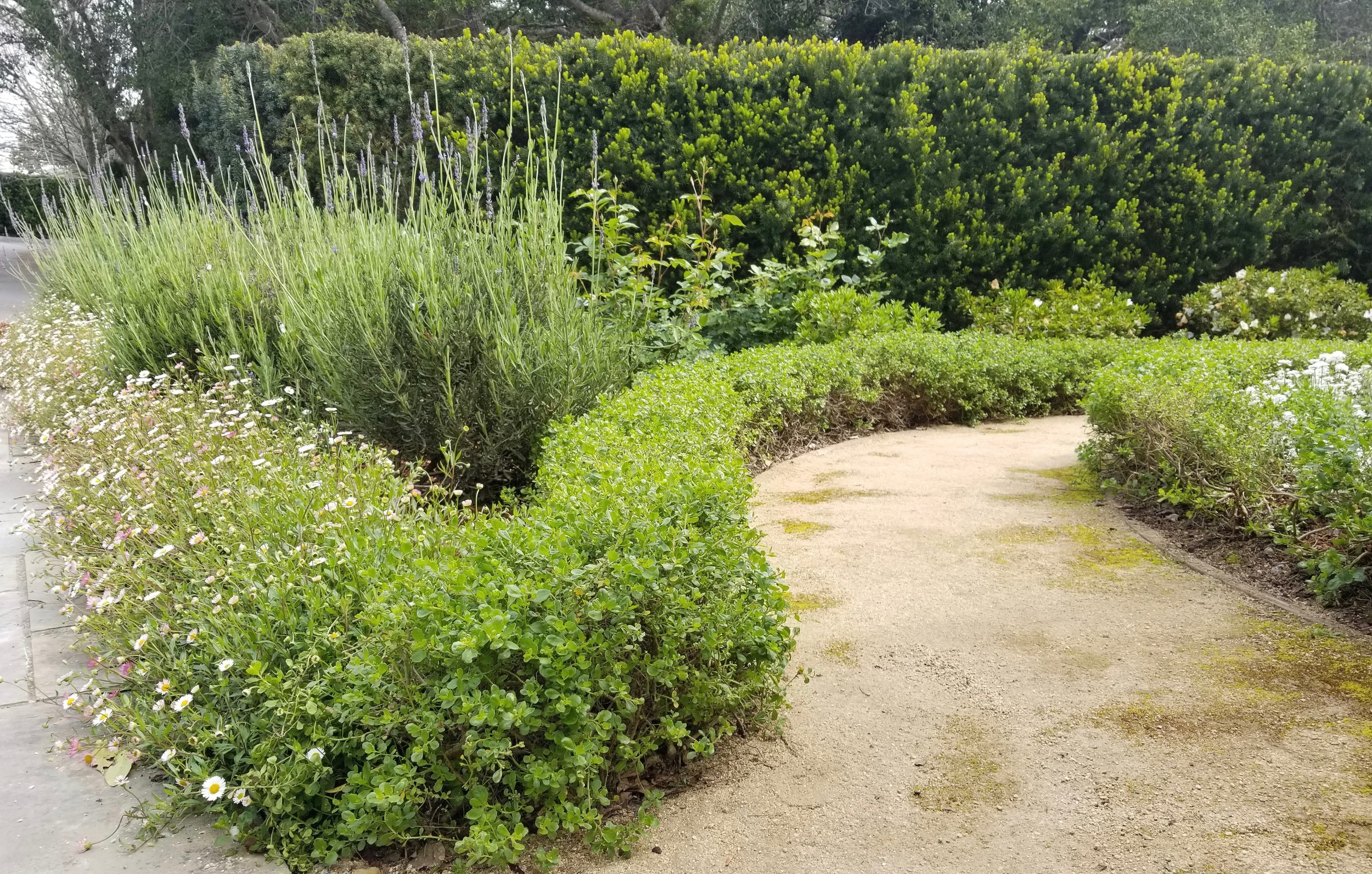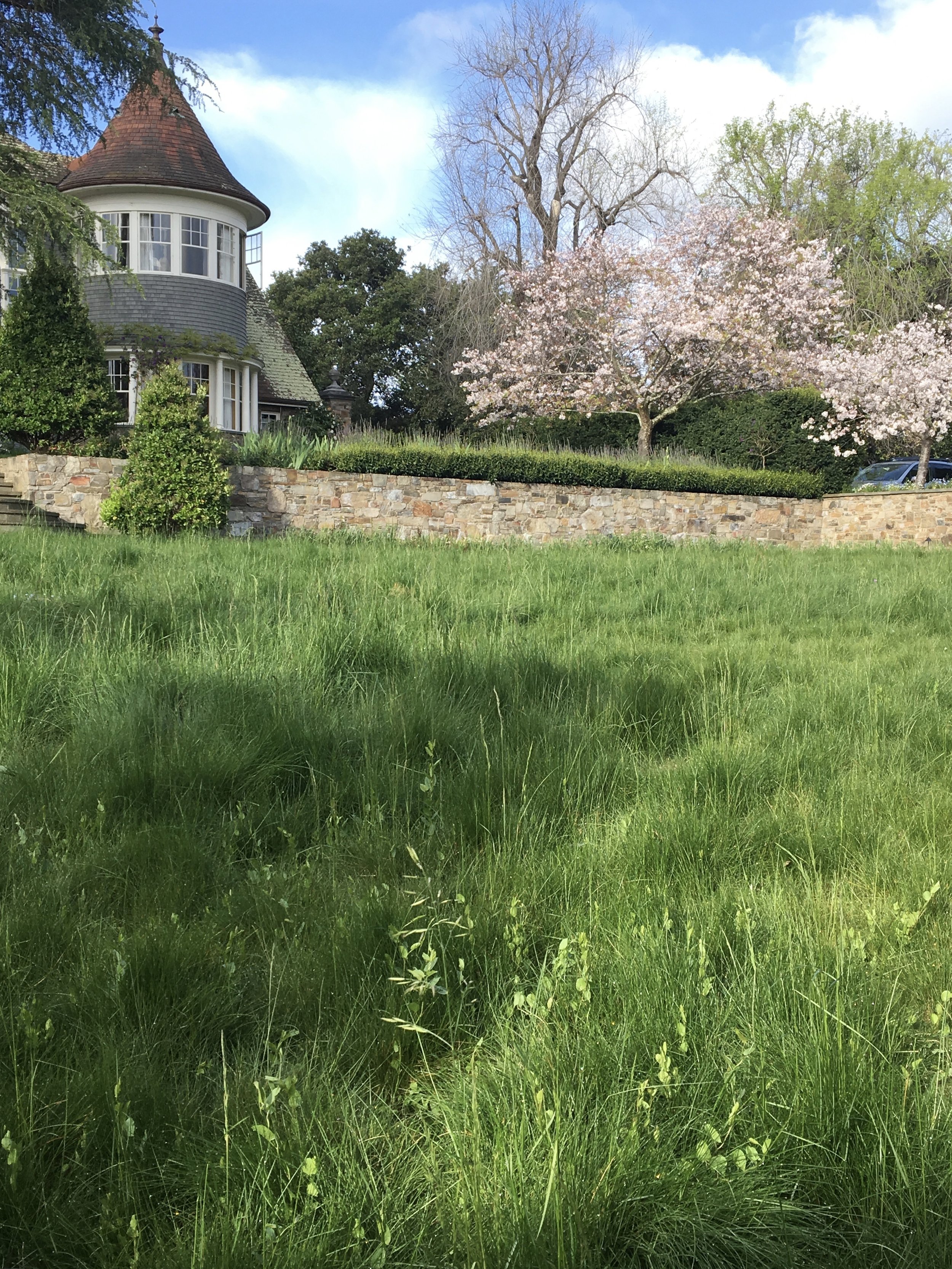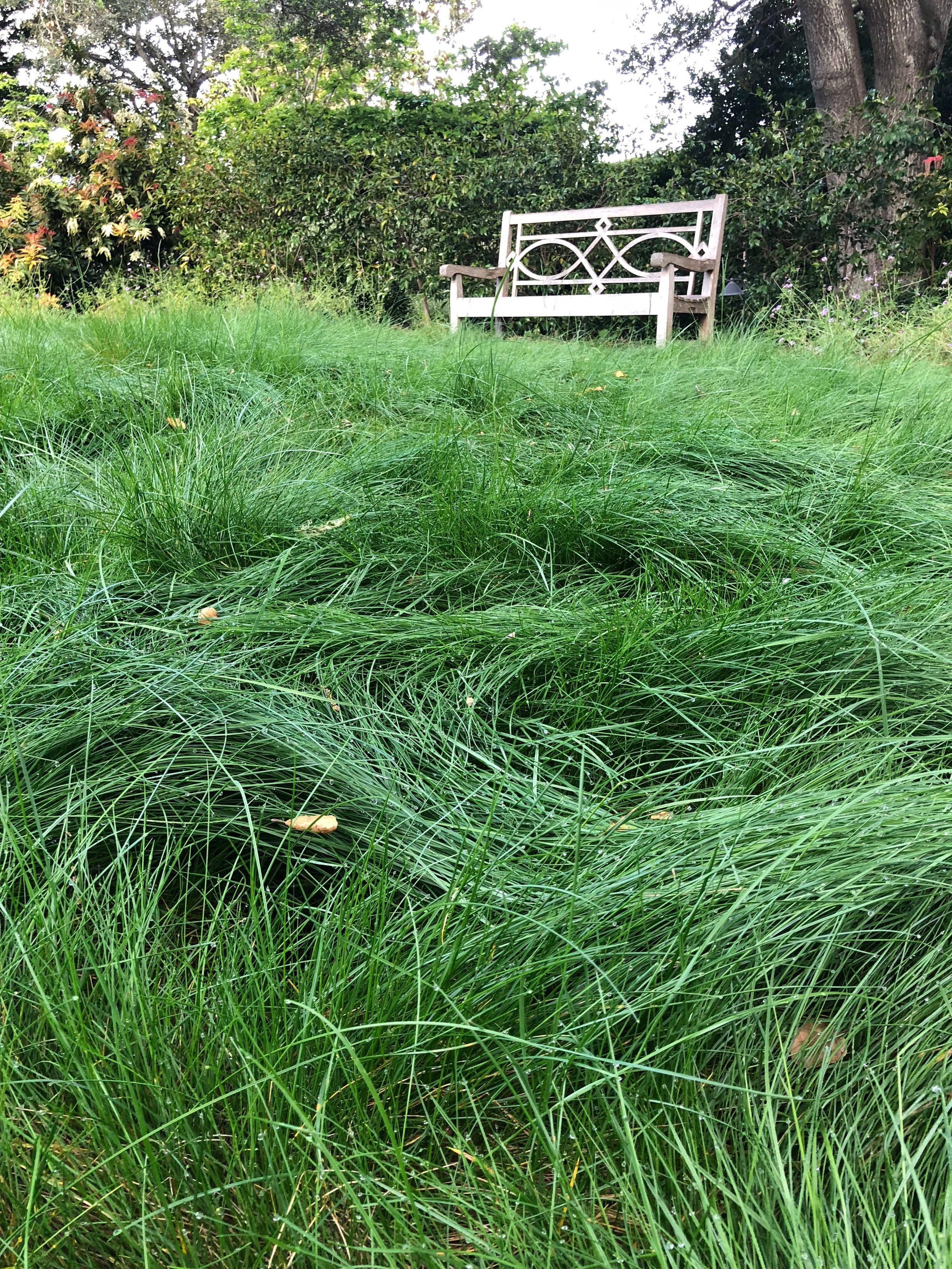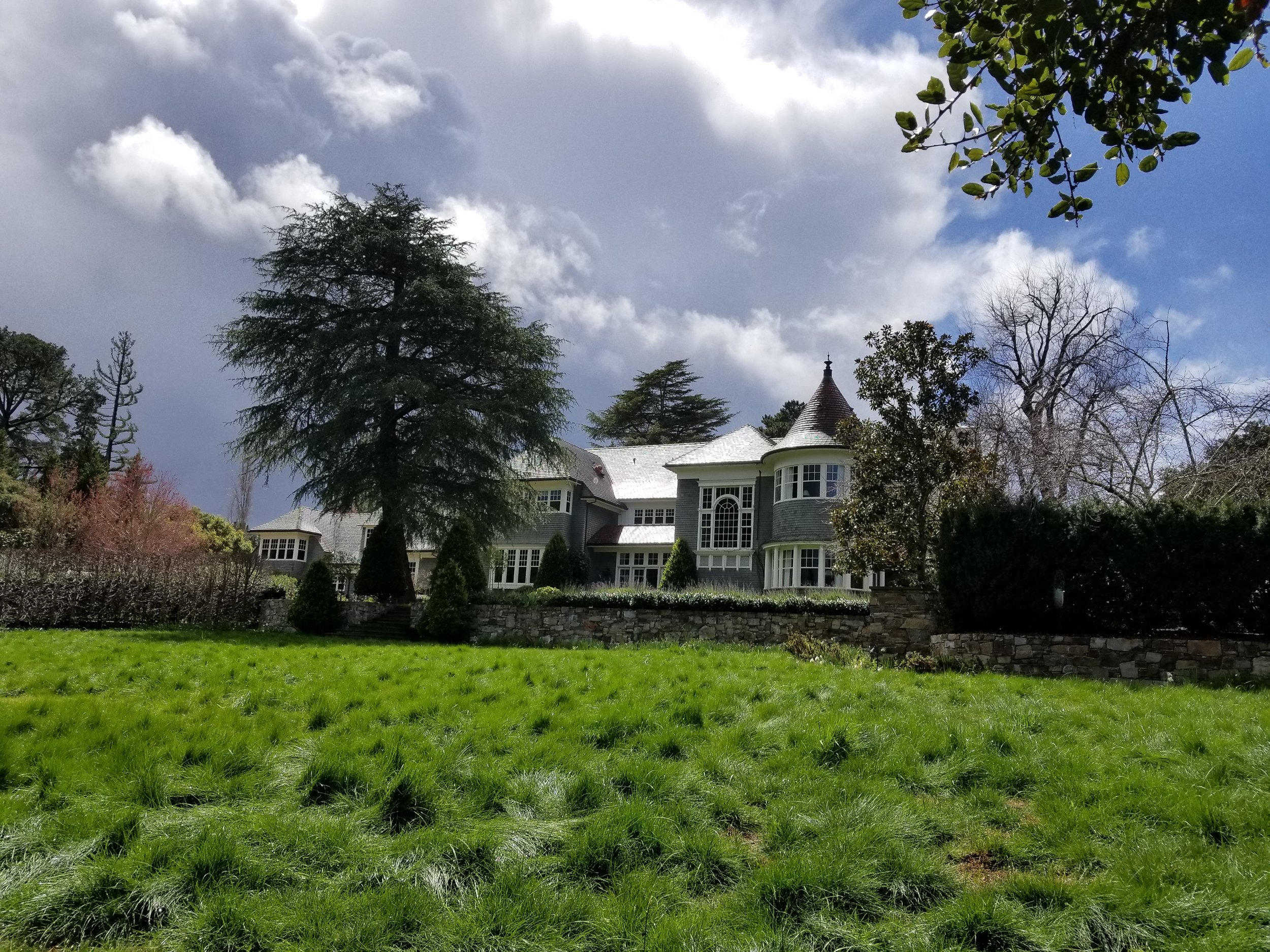The garden of this property is more than a yard, it is a vibrant, natural world inhabited by many creatures. From inside the home, it appears as living art framed by windows and doors.
Diana and Stu, the current owners of this 3+ acre property, purchased it from the heirs of the previous owners in the mid-1990’s. The home was designed by local architect Farro Essalat in the general style of English and east Coast architects working in the “Arts and Crafts” period of the early 20th century. Landscape designer Katsy Swan created an English-style garden to complement it.
The garden is a gathering place for friends and family and has been the site of a number of local fund-raising events. A strolling path encircles the property that allows the walker to encounter woodlands of oak and redwood, a small pond, the guest cottage with its rose garden, a putting green, the solar panel array and numerous planting features and beds. Near the kitchen, an organic vegetable garden supplies the family with greens, herbs, tomatoes, apples and root vegetables throughout the year.
The owners longed to have the yard serve the needs of local wildlife, birds and pollinators while also meeting the restrictions of a continuing drought. In 2014, they hired Julie Swift of Wild Natives to transition the garden to more native plants that also require less water (including milkweed for the monarch butterflies.)
After removing numerous thirsty plants that are traditionally part of the “English” garden, Ms. Swift and her crew designed new plantings of native trees, bushes and flowers while keeping to the original garden design aesthetic. They composted and mulched extensively to improve the soil and reduce water use; replaced the lawns with native grasses; mapped and updated the extensive irrigation system using water-saving practices if possible. Their work and maintenance use no toxins or synthetic chemicals on the property. The garden has truly become a beautiful and healthy haven for every living thing.
Tea Plant - Camelia sinensis
“A new addition to the garden, the tea plants are an experiment in growing organic tea leaves for green and black tea. The starts come from Oregon, where a family farm cultivates, produces and sells teas from mature plants originally brought from Asia.” Diana started seedlings in pots and now has ten plants around the border of the vegetable garden.
Camelia sinensis is used in containers, as a landscape and garden plant, hedge, screen, or foundation plant.
Mature size: 3-4’ or larger
Bloom: White flowers in the fall
Water: Regular watering
Sun/Shade Full sun to part shade
Zones: 7, 8, 9
Yankee Point Wild Lilac - Ceanothus griseas
“The biannual blue/purple blooms are a joy to the owners and the native bees.”
This fast-growing, durable ground cover is all around the property and bears 1 ½ inch long, glossy, dark green leaves and bright blue flower clusters. Despite its coastal origins, ‘Yankee Point’ will grow inland with no watering once established when sited in partial shade. Judicious pruning is recommended to maintain a dense form and promote vigor.
Mature size: 2-3’ tall and 8-12’ wide, plants mound to 5’ tall if planted too close together
Bloom: Bright blue flower clusters winter through early spring
Water: Drought tolerant once established
Sun/Shade: Sun / partial shade
Zone: 9-10
Narrowleaf Milkweed – Asclepias fascicularis
“This native variety of milkweed provides food and breeding opportunities for Monarch butterflies.” (Be prepared for holes in the leaves from the hungry caterpillars!)
The showy flowers of milkweeds offer abundant, high quality nectar to pollinators, making them notable honey bee plants. An enormous range of other pollinators from hummingbirds to butterflies are frequent flower visitors. Milkweeds are named for their milky, latex sap, complex chemicals that make the plants unpalatable to most animals. Choose wisely - some varieties spread like wildfire!
Mature size: 3’ tall x 1’ wide
Bloom: White or lavender blooms all year long
Water needs: Drought tolerant
Sun/Shade: Sun
Zones: 6-10
Catalina Island Bush poppy - Dendromecon harfordii
“This carefree shrub sports cheerful yellow blooms year round, grows fast and thrives in dry shade.”
A wonderful native evergreen shrub with glaucous-green oval leaves.
Mature size: 10-15’ tall / typically 6-10’high x 6-8’ wide
Bloom: Large yellow flowers bloom spring through fall
Water needs: Drought tolerant once established
Sun/Shade: Sun to part shade
Zones: 10a, 10b, 11
Island Verbena - Verbena lilacina
“A year-round bloomer, Island Verbena provides nectar for butterflies and flowers for the garden.”
Extremely showy and drought tolerant.
Mature size: 3’H x 4’W
Bloom: Light purple blooms, March through October
Water needs: Drought tolerant to moderate
Sun/Shade: Sun to part shade
Zones: 7-11
Hummingbird Sage - Salvia spathacea
“This very low maintenance ground cover is a food source for hummingbirds who delight the owners with their regular visits to the garden. The plant thrives in a variety of conditions.”
Hummingbird Sage is a perennial native to coastal California from Napa to Orange. It is deer proof and can tolerate dry shade.
Mature size: 1’ -3’ tall, spreading by rhizomes to 4’ across
Bloom: 1” magenta flowers on a 1-2’ spike, spring through summer
Water needs: Drought tolerant
Sun/Shade: Sun to light shade
Zones: 7-11
White Douglas Iris – Iris douglasiana 'Canyon Snow’
“This iris is a hardy, drought resistant flowering plant that can be tended or mowed. Its spreading clusters outcompete weeds.”
A dependable and floriferous selection of the native Douglas iris, with springtime flowers and broad shiny blades that are mostly evergreen. Too much summer water on heavy soils will prove fatal. Deer resistant.
Mature size: 12-18”, form compact clumps
Bloom: Spring flowers - white flowers with yellow markings
Water needs: Drought tolerant, moderate to little summer water
Sun/Shade: Sun to part shade
Hardiness: to 15°F
American Hornbeam – Carpinus caroliniana
“This hedge delineates spaces in the garden and provides privacy to the pool area. Its verdant spring green leaves darken over summer, turn yellow in autumn before falling to expose an intricate woody structure in winter. The hornbeam hedge is a family favorite.”
The tree is an excellent choice for attracting wildlife, including some highly desirable songbirds and swallowtail butterflies.
Hornbeam pruning depends on your needs. The tree requires very little pruning for good health.
Mature size: 20-40’ tall; 20-30’ wide; slow growth rate, 1’ a year
Bloom: Green catkins blooming in the spring
Water needs: Regular irrigation when young; mature trees drought tolerant
Sun/Shade: Sun or shade
Hardiness: Winter hardy to Zone 3
Coyote Bush - Baccharis pilularis ‘Pigeon Point’
“This fast growing shrub is used in the garden as a drought resistant alternative to boxwood. It can be trimmed to line paths like boxwood, but coyote bush uses less water and does not burn in direct summer sun.”
Coyote bush attracts birds and butterflies and can tolerate deer, erosion, drought and dry soil. It is said to be fire resistant.
Mature size: 1-2’ tall with a spread of 8-10”
Bloom: Yellow, cream or white blooms all year
Water needs: Low
Sun/Shade: Full sun to part shade
Zones: 8-9
Lawn Replacements
Bentgrass - Agrostis pallens
“This native grass populates the upper lawns. Although it can be tended to look like traditional lawn, bentgrass typically requires much less water and maintenance. If allowed to turn golden during dry summer months, it returns to green with the first good rainfall.”
Bentgrass has a deep green color, with medium leaf blades. Grows under 6” tall and uses half the water of a regular lawn.
Mature size: Under 6” tall
Bloom: Small clusters of green spikelets in spring
Water needs: Low
Sun/Shade: Sun, part shade, full shade
Hardiness: Cold to -10°F
Meadow Grass
“This grass blend creates a lush meadow requiring minimal watering and one mow per year at most. Its appearance is soothing and it provides habitat for insects and wildlife, both part of a healthy garden ecosystem.”
Diana's blend includes the following :
Creeping Red Fescue - Festuca rubra
Creeping Red Fescue is a fine bladed grass with medium to dark green color. It is easily established from seed and spreads with rhizomes with a "creeping" growth habit. Its major use is for dry shaded areas as either a pure stand or as a mixture in other grass seed mixtures. Even though it is one of the best grasses for use in shade it will tolerate full sun conditions although this could require more water. Creeping Red Fescue is used extensively in all types of turf areas including parks, roadsides, lawns, fairways, cemeteries, airfields, and other turf areas.
Mature Size: 12-24” tall (can be mowed)
Bloom: Flower spikelets in early to mid summer
Water needs: Low
Sun/Shade: Partial shade, shade, can tolerate sun
Zones: 1-7; annual in zones 8-10
Idaho fescue – Festuca idahoensis
Idaho fescue can be used in xeriscape design and can survive years without maintenance. It’s an excellent plant for all regions of the arid West. It has a formal upright appearance that is quite effective in a mass planting. It is a cool season crop; clump forming; foliage is variable green to blue-green.
Mature Size: 8-16” tall
Bloom: Flowers May through June
Water needs: Low, drought tolerant
Sun/Shade: Full sun to light shade
Zones: 3-9
Western Mokelumne Fescue – Festuca occidentalis
Native to much of North American, this pretty, bright green form was selected by David Fross near the Mokelumne River. A nice grass to use in the woodland garden, it does well in dappled shade with only occasional water, making a good choice for planting under oaks.
Mature size: 3’H x 3’W mounds
Bloom: Seed heads in spring
Water needs: Low, drought tolerant
Sun/Shade: Sun, part shade
Hardiness: To 15°F
Purple Needlegrass - Nasella pulchra
Purple needlegrass is a densely tufted, long-lived, upright perennial bunchgrass with long awns. It is an excellent native grass for use in low water landscaping; it has been used in native grass lawns, but its bunching habit prevents it from forming a uniform sod. It goes dormant in the summer and greens up in fall with the first rainfall and the shorter days.
Note: Animals such as dogs have been known to get the seed lodged in their fur.
Mature size: 2-3’ tall
Bloom: Showy seed heads in spring to early summer
Water Needs: Low to average
Sun/Shade: Sun to light shade
Zones: 7-11

















